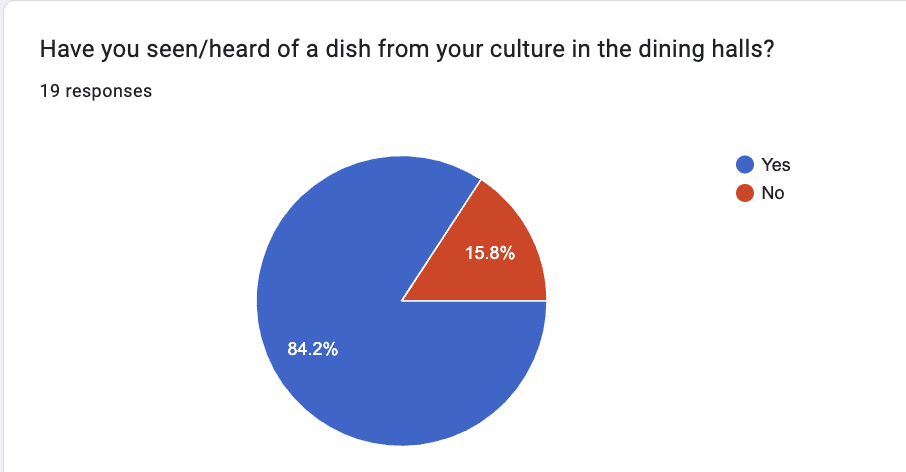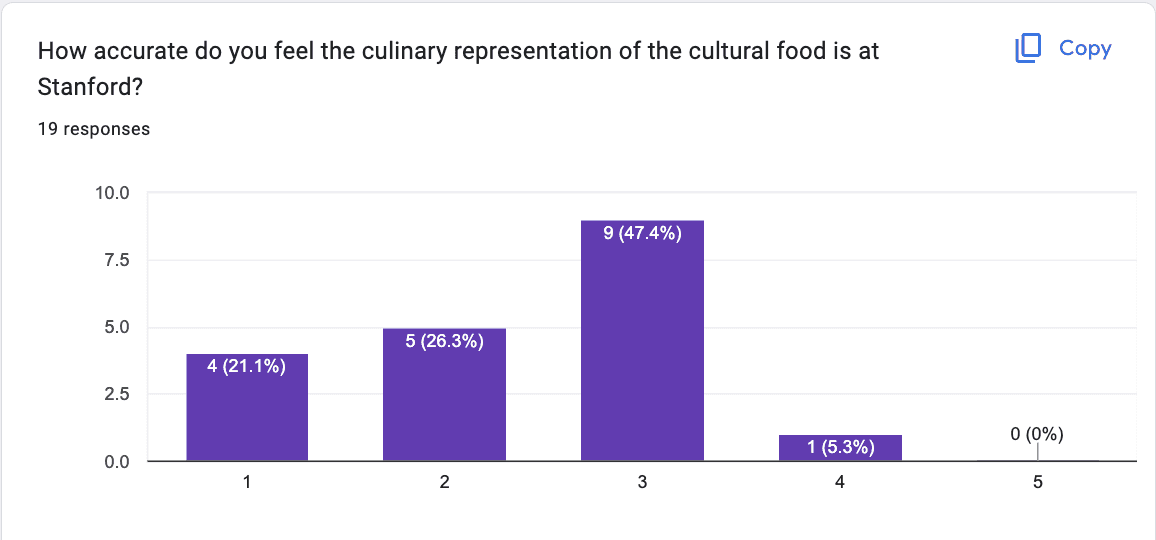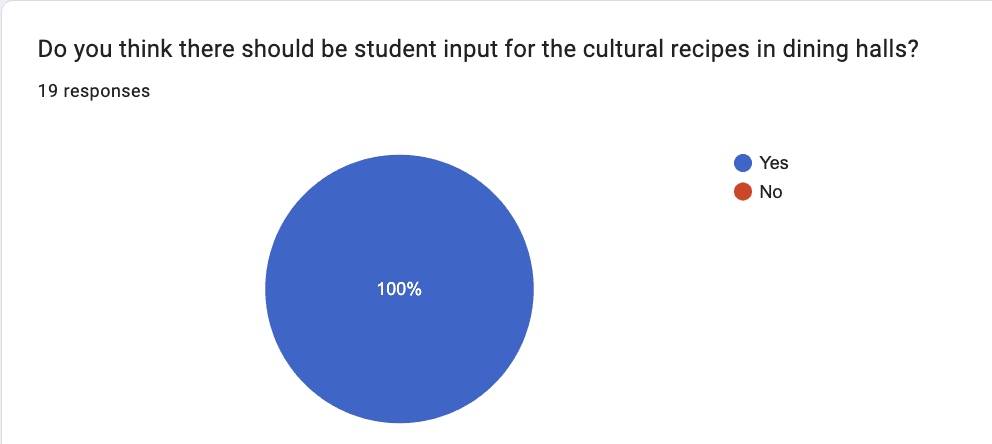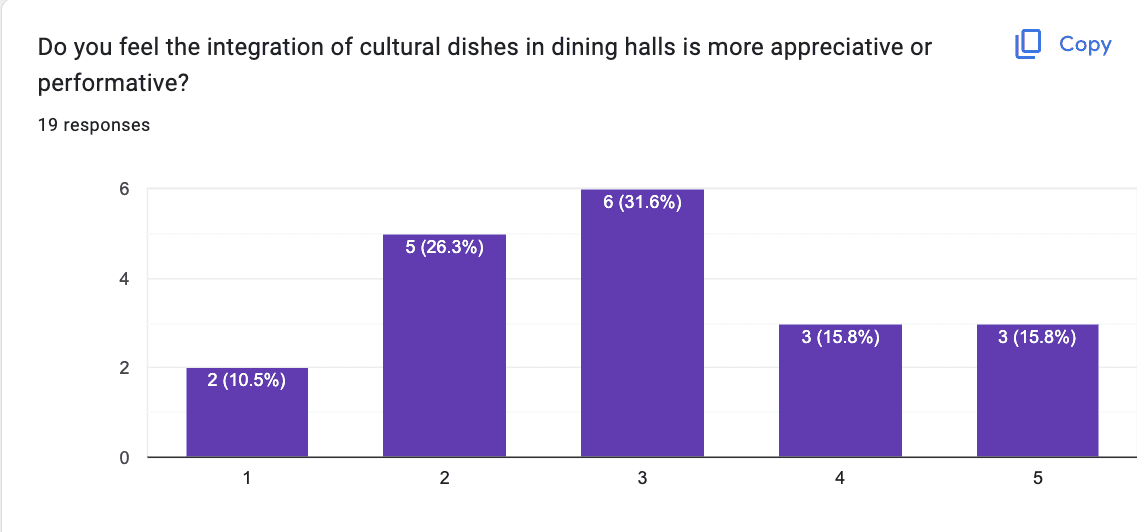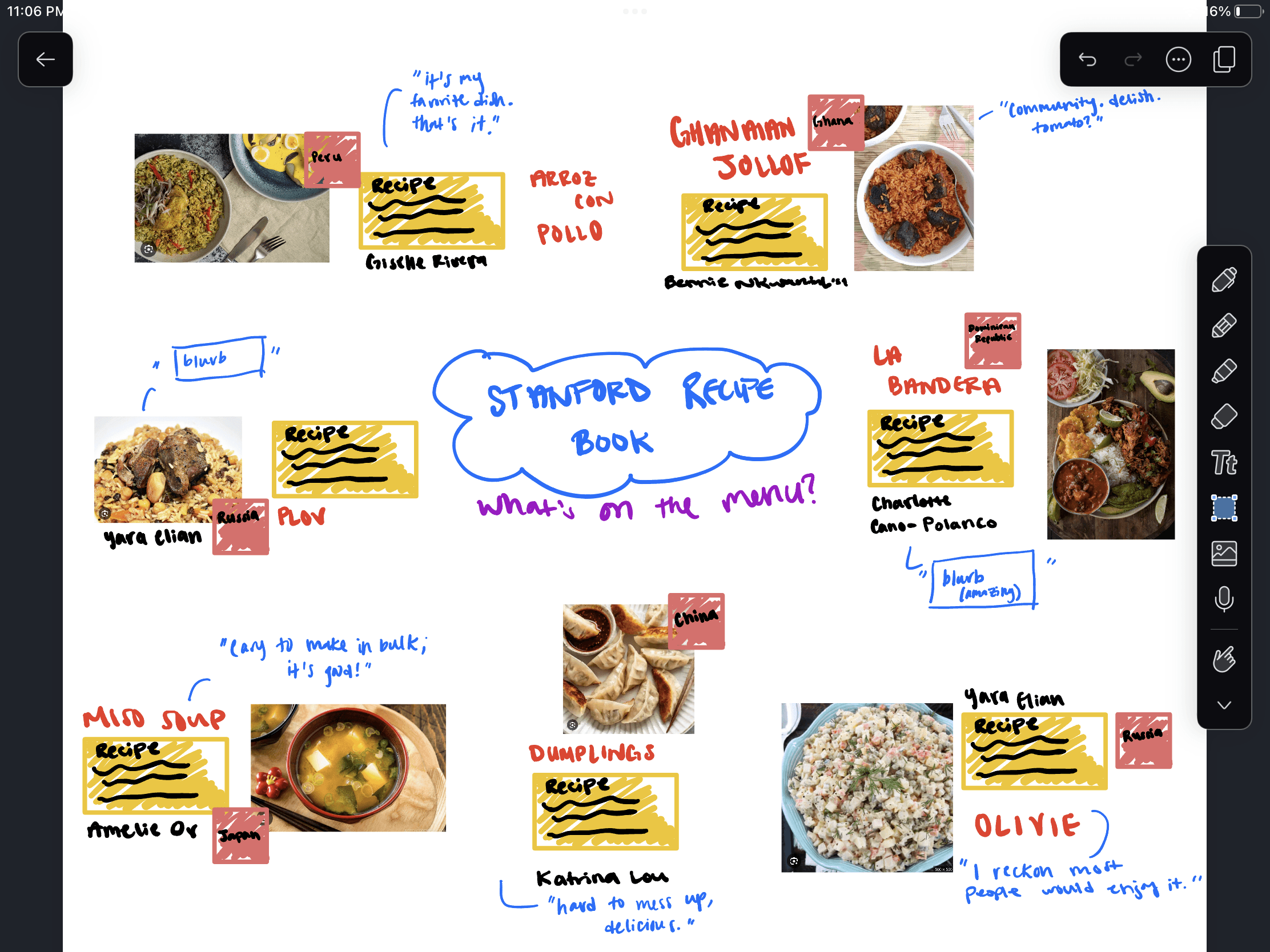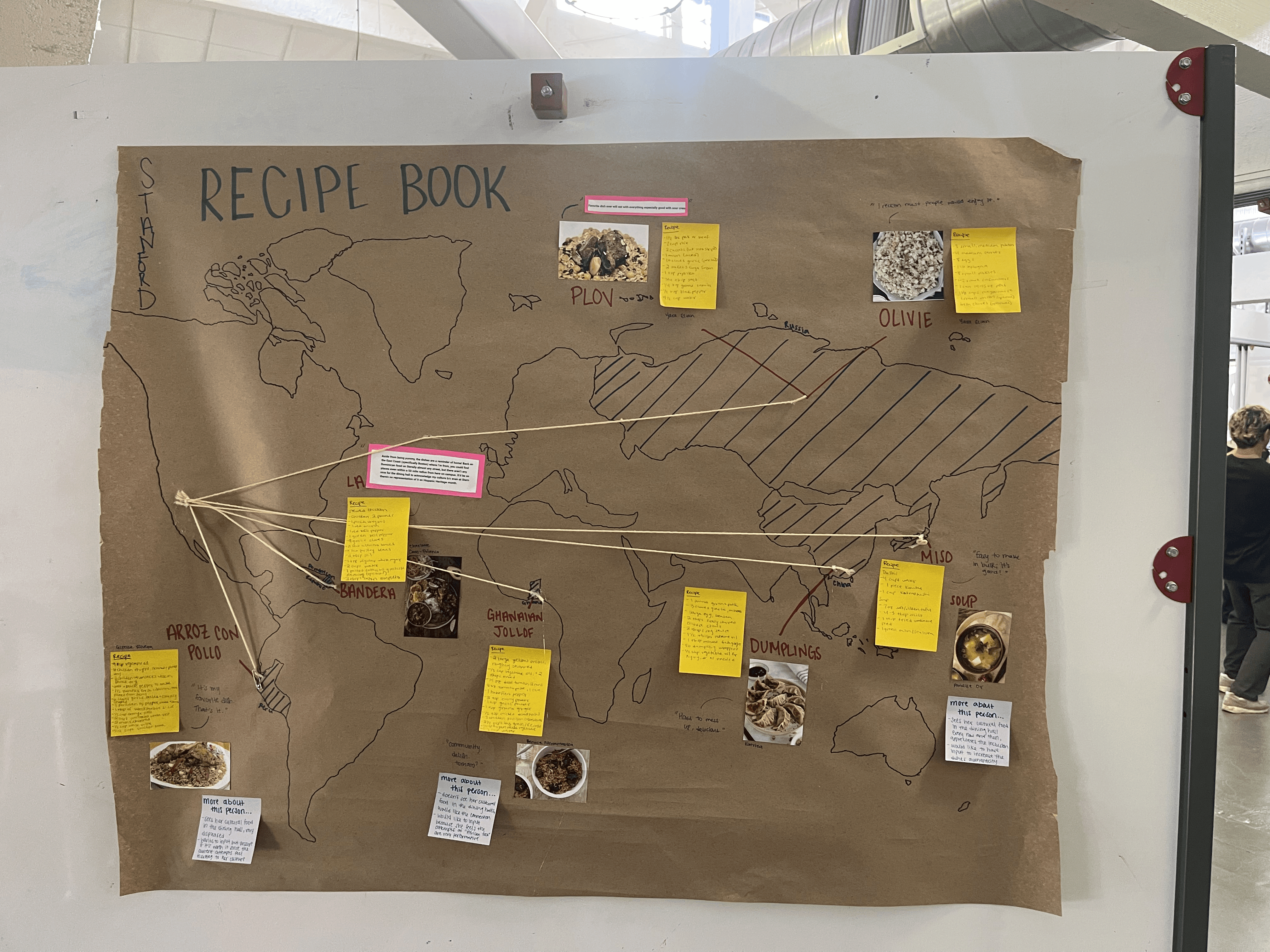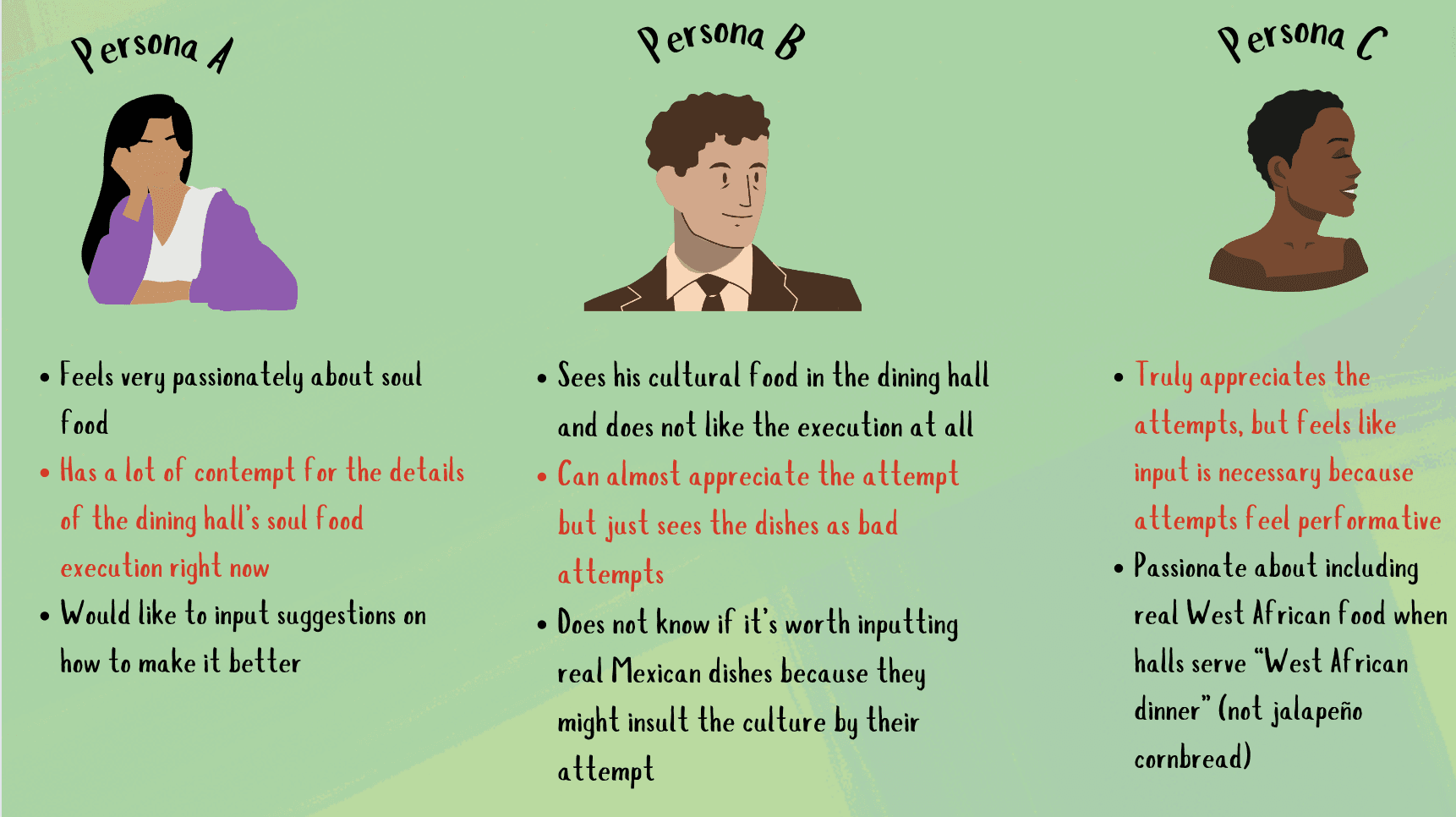Centered around the topic of community and belonging amongst undergraduates at Stanford, this project was an exploratory research study with the goal of collecting student insights on culinary inclusion in Stanford dining facilities.
↓ scroll below for more ↓
User Research
Needfinding
UI/UX
This page is currently under construction! Please excuse the formatting while I reconstruct this project. Thank you!
This page is currently under construction! Please excuse the formatting while I reconstruct this project. Thank you!
This page is currently under construction! Please excuse the formatting while I reconstruct this project. Thank you!
Project spotlight from the Stanford d.school via LinkedIn (2:30)
Project spotlight from the Stanford d.school via LinkedIn (2:30)
Click to view full video:
Click to view full video:
HOW MIGHT WE integrate and collect more student input into the planning and execution of cultural dishes in dining halls to ensure that the community and belonging aspects of culinary inclusion are achieved?
ORIGINS
Disclaimer: With the structure of the project being an elongated design sprint,
the final deliverable was a presentation-based prototype.
When tasked with creating a prototype for a solution to create community within Stanford undergraduates, I chose to look at one of the most common community spaces: the dining halls.
As a Ghanaian-American, I have always been proud of my African-American upbringing- being raised with Ghanaian, food culture, and language at home and American schools, people, and traditions elsewhere. I have twice seen a proud staple of Ghanaian food in the dining halls, and both times, the execution was so unappealing to me that I would have rather not had the university-attempted option present.
The color was the most prominent mistake, which told me that they had not used as much of some ingredients as they should have; this led me to realize that it could be very beneficial if there was some sort of recipe book or feedback system so that students could feel that their dishes and their cultures were accurately represented (especially because there are lots of cultural groups on campus who have likely never seen a dish of theirs in the dining hall at all).
Guiding Research Question: If students were given the option to provide input on cultural dishes in dining halls, would they want to?
When tasked with creating a prototype for a solution to create community within Stanford undergraduates, I chose to look at one of the most common community spaces: the dining halls.
As a Ghanaian-American, I have always been proud of my African-American upbringing- being raised with Ghanaian, food culture, and language at home and American schools, people, and traditions elsewhere. I have twice seen a proud staple of Ghanaian food in the dining halls, and both times, the execution was so unappealing to me that I would have rather not had the university-attempted option present.
The color was the most prominent mistake, which told me that they had not used as much of some ingredients as they should have; this led me to realize that it could be very beneficial if there was some sort of recipe book or feedback system so that students could feel that their dishes and their cultures were accurately represented (especially because there are lots of cultural groups on campus who have likely never seen a dish of theirs in the dining hall at all).
Guiding Research Question: If students were given the option to provide input on cultural dishes in dining halls, would they want to?
When tasked with creating a prototype for a solution to create community within Stanford undergraduates, I chose to look at one of the most common community spaces: the dining halls.
As a Ghanaian-American, I have always been proud of my African-American upbringing- being raised with Ghanaian, food culture, and language at home and American schools, people, and traditions elsewhere. I have twice seen a proud staple of Ghanaian food in the dining halls, and both times, the execution was so unappealing to me that I would have rather not had the university-attempted option present.
The color was the most prominent mistake, which told me that they had not used as much of some ingredients as they should have; this led me to realize that it could be very beneficial if there was some sort of recipe book or feedback system so that students could feel that their dishes and their cultures were accurately represented (especially because there are lots of cultural groups on campus who have likely never seen a dish of theirs in the dining hall at all).
Guiding Research Question: If students were given the option to provide input on cultural dishes in dining halls, would they want to?
When tasked with creating a prototype for a solution to create community within Stanford undergraduates, I chose to look at one of the most common community spaces: the dining halls.
As a Ghanaian-American, I have always been proud of my African-American upbringing- being raised with Ghanaian, food culture, and language at home and American schools, people, and traditions elsewhere. I have twice seen a proud staple of Ghanaian food in the dining halls, and both times, the execution was so unappealing to me that I would have rather not had the university-attempted option present.
The color was the most prominent mistake, which told me that they had not used as much of some ingredients as they should have; this led me to realize that it could be very beneficial if there was some sort of recipe book or feedback system so that students could feel that their dishes and their cultures were accurately represented (especially because there are lots of cultural groups on campus who have likely never seen a dish of theirs in the dining hall at all).
Guiding Research Question: If students were given the option to provide input on cultural dishes in dining halls, would they want to?
User Interviews + Insights
User Interviews + Insights
Being an active member of many cultural groups and spaces on campus, I sent out a survey to as many students as I could asking them about their thoughts and attitudes towards cultural dishes in the dining halls, based on their experiences. I was unsure if this idea was worth pursuing since I didn't know if the uneasy feelings were shared, but the results said otherwise:
Being an active member of many cultural groups and spaces on campus, I sent out a survey to as many students as I could asking them about their thoughts and attitudes towards cultural dishes in the dining halls, based on their experiences. I was unsure if this idea was worth pursuing since I didn't know if the uneasy feelings were shared, but the results said otherwise:
Students see dishes from their culture in the dining hall, but feel negatively about this.
Students see dishes from their culture in the dining hall, but feel negatively about this.
Of the 19 students surveyed, 84.2% claimed to have seen or heard of their cultural dish, but 60% responded as feeling negatively about it. When asked to further elaborate, responded with a variety of critiques that mostly centered around the incorrect preparation of the dish.
Survey results regarding awareness of cultural representation in dining halls
Survey results regarding awareness of cultural representation in dining halls
Though the majority adjusted, the apparent skew towards negative feeling provided a clear sign that students felt an underlying unhappiness towards their culinary representation. This possibility led me to wonder what the cause of the lack of vocalization about this unhappiness might be.
Though the majority adjusted, the apparent skew towards negative feeling provided a clear sign that students felt an underlying unhappiness towards their culinary representation. This possibility led me to wonder what the cause of the lack of vocalization about this unhappiness might be.
Students are unsure as to how much their input on cultural dining hall dishes currently matters.
Students are unsure as to how much their input on cultural dining hall dishes currently matters.
Students are unsure as to how much their input on cultural dining hall dishes currently matters.
The overwhelming majority of survey responses showed that students believe that their culinary representation in dining halls is not accurate; all believed that there should be student input. The reported findings aligned with suspected attitudes mentioned in the previous survey results.
The overwhelming majority of survey responses showed that students believe that their culinary representation in dining halls is not accurate; all believed that there should be student input. The reported findings aligned with suspected attitudes mentioned in the previous survey results.
Culinary representation results (Top: 1 being "Very Inaccurate", 5 being "Very Accurate")
Culinary representation results (Top: 1 being "Very Inaccurate", 5 being "Very Accurate")
Culinary representation results (Top: 1 being "Very Inaccurate", 5 being "Very Accurate")
I previously suspected that some students might find the school's use of cultural dishes performative if they also believed that the dishes were executed poorly, but when asked if cultural dishes in dining halls felt more performative or appreciative, responses followed an almost-normal distribution, boasting only a very slight skew towards performative integration. This, in conjunction with the accuracy attitudes and negative feelings suggests that although students might be unhappy with how their cultures are being represented and want to be involved in changing this, they may not necessarily believe that the poor execution of cultural dishes is due to apathy or superficial attempts on the school's behalf to seem more diverse and accommodating. Though there could be many reasons why students are not more vocal about their feelings, I suspected that if students do not feel the school is acting with malicious intent, they might not speak up because they do not know if what they say will make a difference.
I previously suspected that some students might find the school's use of cultural dishes performative if they also believed that the dishes were executed poorly, but when asked if cultural dishes in dining halls felt more performative or appreciative, responses followed an almost-normal distribution, boasting only a very slight skew towards performative integration. This, in conjunction with the accuracy attitudes and negative feelings suggests that although students might be unhappy with how their cultures are being represented and want to be involved in changing this, they may not necessarily believe that the poor execution of cultural dishes is due to apathy or superficial attempts on the school's behalf to seem more diverse and accommodating. Though there could be many reasons why students are not more vocal about their feelings, I suspected that if students do not feel the school is acting with malicious intent, they might not speak up because they do not know if what they say will make a difference.
University performance results: 1 being "Performative", 5 being "Appreciative"
University performance results: 1 being "Performative", 5 being "Appreciative"
University performance results: 1 being "Performative", 5 being "Appreciative"
Student Testimonials
Explanations on why responders felt positively or negatively about seeing a cultural dish of theirs in dining halls.
Carnitas were bad, fajitas tasted like rubber.
I didn’t expect it to taste as good as when the dish is served normally, and I was right.
I appreciate how they attempt to serve dishes from a variety of cultures.
They usually don’t prepare it traditionally.
Whenever they have would food in the dining halls it’s very whitewashed and under seasoned. With the macaroni, they don’t even take the care to bake it, and the greens are either hard or too salty. They also can’t ever get fried chicken right. They texture just isn’t what fried chicken should be at all.
It was sweet! Although the dish wasn’t very culturally accurate lol. But it’s the thought that counts.
It was so bad, it felt like a hate crime.
I was happy to see my culture represented at Stanford, but ultimately disappointed in the depiction.
They completely butchered it.
The dish (biryani) was made with no where near the right ingredients. Brown rice, sweet, and overpowering taste of cinnamon, which is not right.
Deciding that input was one of the most important factors in increasing a sense of community and belonging amongst students through dining halls, I created the prototype of The Stanford Recipe Book, an inclusive platform on which students could not only suggest dishes to university dining halls, but provide specific recipes and anecdotes that show why they love the dish. The idea was that personalizing the recipes and dishes with connections from home would remind students eating the dishes of similar connections, thereby increasing their feelings of genuine representation in dining halls. After all, the central notion throughout the creation of this project was that we are all connected through food, and food connects us to home.
L: Early presentation prototype, R: Final low-fidelity presentation prototype
L: Early presentation prototype, R: Final low-fidelity presentation prototype
Through analyzing the survey data, I created three personas that I felt best represented the types of students to whom the Stanford Recipe Book would most appeal to.
Through analyzing the survey data, I created three personas that I felt best represented the types of students to whom the Stanford Recipe Book would most appeal to.
Interpretation Limitations
Interpretation Limitations
The interpretations of the results used to guide the creation of the final low-fidelity prototype could vary due to the limited and open-ended nature of the survey results. The sample size of n=19ˆ was not large enough to draw any definitive conclusions that reflect the true opinions on culinary inclusion for all Stanford undergraduates, though it was large enough to provide a starting point for the project. By nature of the quick design challenge, I collected as many responses as I was able to, but this still does not mean that every undergraduate Stanford student's feelings are accounted for within the results or the three personas.
The final deliverable was a low-fidelity paper prototype as well as a brief presentation in a gallery-style setting. I styled my prototype after what I thought would be the ideal format of the recipe book's entries: an interactive platform on which students can select anywhere in the world to see what recipes might have been donated by other students as well as the snippet provided about their connection to the dish. Additionally, I made the choice to emphasize the country from which the recipe originated as well as the line from the country of origin to Stanford to highlight the individuality of the country and its connection to all of the others at Stanford. Prototyping on paper made me realize the benefit of pursuing a digital prototype should I decide to take this project further so that the potential interactive element of the map could be tested.
The final deliverable was a low-fidelity paper prototype as well as a brief presentation in a gallery-style setting. I styled my prototype after what I thought would be the ideal format of the recipe book's entries: an interactive platform on which students can select anywhere in the world to see what recipes might have been donated by other students as well as the snippet provided about their connection to the dish. Additionally, I made the choice to emphasize the country from which the recipe originated as well as the line from the country of origin to Stanford to highlight the individuality of the country and its connection to all of the others at Stanford. Prototyping on paper made me realize the benefit of pursuing a digital prototype should I decide to take this project further so that the potential interactive element of the map could be tested.
Measuring Success in Next Steps
Measuring Success in Next Steps
The success of the Recipe Book would be evident to me once students felt that the dishes from their culture in the dining halls genuinely reflected them because they had the ability to contribute to the dish's execution. Throughout the survey collection process, the most rewarding pieces of feedback I received expressed gratitude for addressing an issue that many felt had been completely ignored. Though I have not yet pursued the project past the final deliverable, my next steps towards advancing the Stanford Recipe Book would be:
Publicize the input survey on a more widespread scale,
Open the recipe book input for Stanford undergraduates, beginning with the ethnic theme houses and associations.
Coordinate with Residential & Dining Enterprises (R&DE) to make room on their website for input on dishes
Ex. You really liked or disliked a dish
What they could do better next time (cook longer, add more of __ seasoning, etc.)
Idea for another dish (Ghanaian dish this time? jollof, waakye, etc. next time)
Eventually, in my hopeful world, coordination between students and dining enterprises would feel less restrictive, and the feeling of one's opinion not mattering to the school would be significantly lessened!
The success of the Recipe Book would be evident to me once students felt that the dishes from their culture in the dining halls genuinely reflected them because they had the ability to contribute to the dish's execution. Throughout the survey collection process, the most rewarding pieces of feedback I received expressed gratitude for addressing an issue that many felt had been completely ignored. Though I have not yet pursued the project past the final deliverable, my next steps towards advancing the Stanford Recipe Book would be:
Publicize the input survey on a more widespread scale,
Open the recipe book input for Stanford undergraduates, beginning with the ethnic theme houses and associations.
Coordinate with Residential & Dining Enterprises (R&DE) to make room on their website for input on dishes
Ex. You really liked or disliked a dish
What they could do better next time (cook longer, add more of __ seasoning, etc.)
Idea for another dish (Ghanaian dish this time? jollof, waakye, etc. next time)
Eventually, in my hopeful world, coordination between students and dining enterprises would feel less restrictive, and the feeling of one's opinion not mattering to the school would be significantly lessened!
Stories about encounters with cultural dishes in the dining hall (their culture, not their culture, feelings, tastes, etc.)
Stories about encounters with cultural dishes in the dining hall (their culture, not their culture, feelings, tastes, etc.)
I find that for soul food and foods from the black diaspora, they don’t have the input of someone from that culture to base their recipes and cooking methods off of. Because when I see a black person in the kitchen, the attempt is better.
I love when the chef preparing the cultural dish is from that culture since I can connect with them more easily (one time, an Indian chef at Arrillaga asked me about what my favorite Indian foods are and invited me to come back on a specific day when he’d be making dosas!)
Oftentimes RD&E slaps an “ethnic” name on a dish just to make it seem different. As an African-American, I’ve been disappointed by almost all the soul food that’s been served at the dining halls. The collard greens aren’t cooked like traditional greens, the fried chicken is soggy, the North Carolina bbq chicken is disappointing, and so on. They’ve done even worse at representing other cultures: they turned Somalian beef suqaar (a stir-fry type of dish) into a stew, they use jollof rice as a name for yellow rice and peas, and made a blasphemy of Filipino chicken adobo. Representation is good if you at least attempt to be true to the culture; the Stanford dining halls do not.
While the cultural dishes are not close to the real thing, I think that the dining hall staff is trying to appreciate different cultures. They just need more student input to make it better, but they are trying!
The Stanford Recipe Book was my first solo design project, and since then, I have been fascinated by the role research plays in designing products and experiences. Though the final deliverable was a prototype, its reception taught me what a prototype can be: a means to express ideas and solutions. I was very delighted to find that those who viewed my presentation were able to understand the goal of the project, so much so that I was honored to have it featured in a spotlight by the Design program as part of the Stanford d.school. The Recipe Book was not created as a means to visibly complain about Stanford dining halls; it is a means to bridge the gap between the university and student communications while appreciating the work that goes into providing an entire campus with meals that at least try to be inclusive of the many, many student cultures that make Stanford as brilliant as it is. Figuring out how to promote community and a sense of belonging amongst undergraduates and highlighting what makes every Stanford student special is something that the university strives to do wherever possible. With the Stanford Recipe Book, not only does the university get to recognize our unique differences- so do we.
The Stanford Recipe Book was my first solo design project, and since then, I have been fascinated by the role research plays in designing products and experiences. Though the final deliverable was a prototype, its reception taught me what a prototype can be: a means to express ideas and solutions. I was very delighted to find that those who viewed my presentation were able to understand the goal of the project, so much so that I was honored to have it featured in a spotlight by the Design program as part of the Stanford d.school. The Recipe Book was not created as a means to visibly complain about Stanford dining halls; it is a means to bridge the gap between the university and student communications while appreciating the work that goes into providing an entire campus with meals that at least try to be inclusive of the many, many student cultures that make Stanford as brilliant as it is. Figuring out how to promote community and a sense of belonging amongst undergraduates and highlighting what makes every Stanford student special is something that the university strives to do wherever possible. With the Stanford Recipe Book, not only does the university get to recognize our unique differences- so do we.







